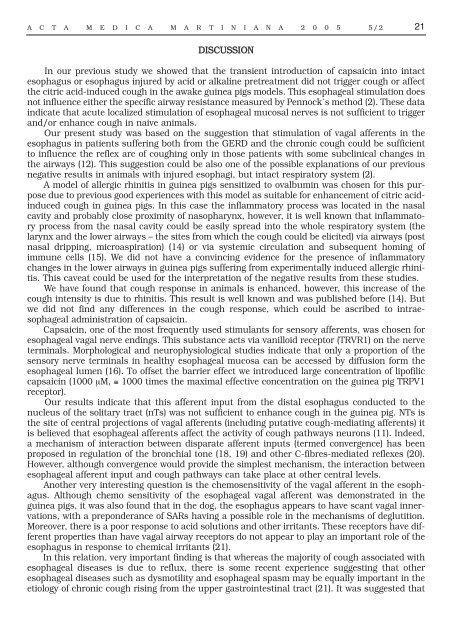MAKETA 5/2 po
MAKETA 5/2 po
MAKETA 5/2 po
You also want an ePaper? Increase the reach of your titles
YUMPU automatically turns print PDFs into web optimized ePapers that Google loves.
A C T A M E D I C A M A R T I N I A N A 2 0 0 5 5/2 21<br />
DISCUSSION<br />
In our previous study we showed that the transient introduction of capsaicin into intact<br />
esophagus or esophagus injured by acid or alkaline pretreatment did not trigger cough or affect<br />
the citric acid-induced cough in the awake guinea pigs models. This esophageal stimulation does<br />
not influence either the specific airway resistance measured by Pennock`s method (2). These data<br />
indicate that acute localized stimulation of esophageal mucosal nerves is not sufficient to trigger<br />
and/or enhance cough in naive animals.<br />
Our present study was based on the suggestion that stimulation of vagal afferents in the<br />
esophagus in patients suffering both from the GERD and the chronic cough could be sufficient<br />
to influence the reflex arc of coughing only in those patients with some subclinical changes in<br />
the airways (12). This suggestion could be also one of the <strong>po</strong>ssible explanations of our previous<br />
negative results in animals with injured esophagi, but intact respiratory system (2).<br />
A model of allergic rhinitis in guinea pigs sensitized to ovalbumin was chosen for this pur<strong>po</strong>se<br />
due to previous good experiences with this model as suitable for enhancement of citric acidinduced<br />
cough in guinea pigs. In this case the inflammatory process was located in the nasal<br />
cavity and probably close proximity of nasopharynx, however, it is well known that inflammatory<br />
process from the nasal cavity could be easily spread into the whole respiratory system (the<br />
larynx and the lower airways – the sites from which the cough could be elicited) via airways (<strong>po</strong>st<br />
nasal dripping, microaspiration) (14) or via systemic circulation and subsequent homing of<br />
immune cells (15). We did not have a convincing evidence for the presence of inflammatory<br />
changes in the lower airways in guinea pigs suffering from experimentally induced allergic rhinitis.<br />
This caveat could be used for the interpretation of the negative results from these studies.<br />
We have found that cough res<strong>po</strong>nse in animals is enhanced, however, this increase of the<br />
cough intensity is due to rhinitis. This result is well known and was published before (14). But<br />
we did not find any differences in the cough res<strong>po</strong>nse, which could be ascribed to intraesophageal<br />
administration of capsaicin.<br />
Capsaicin, one of the most frequently used stimulants for sensory afferents, was chosen for<br />
esophageal vagal nerve endings. This substance acts via vanilloid receptor (TRVR1) on the nerve<br />
terminals. Morphological and neurophysiological studies indicate that only a pro<strong>po</strong>rtion of the<br />
sensory nerve terminals in healthy esophageal mucosa can be accessed by diffusion form the<br />
esophageal lumen (16). To offset the barrier effect we introduced large concentration of li<strong>po</strong>filic<br />
capsaicin (1000 μM, ≅ 1000 times the maximal effective concentration on the guinea pig TRPV1<br />
receptor).<br />
Our results indicate that this afferent input from the distal esophagus conducted to the<br />
nucleus of the solitary tract (nTs) was not sufficient to enhance cough in the guinea pig. NTs is<br />
the site of central projections of vagal afferents (including putative cough-mediating afferents) it<br />
is believed that esophageal afferents affect the activity of cough pathways neurons (11). Indeed,<br />
a mechanism of interaction between disparate afferent inputs (termed convergence) has been<br />
pro<strong>po</strong>sed in regulation of the bronchial tone (18, 19) and other C-fibres-mediated reflexes (20).<br />
However, although convergence would provide the simplest mechanism, the interaction between<br />
esophageal afferent input and cough pathways can take place at other central levels.<br />
Another very interesting question is the chemosensitivity of the vagal afferent in the esophagus.<br />
Although chemo sensitivity of the esophageal vagal afferent was demonstrated in the<br />
guinea pigs, it was also found that in the dog, the esophagus appears to have scant vagal innervations,<br />
with a pre<strong>po</strong>nderance of SARs having a <strong>po</strong>ssible role in the mechanisms of deglutition.<br />
Moreover, there is a <strong>po</strong>or res<strong>po</strong>nse to acid solutions and other irritants. These receptors have different<br />
properties than have vagal airway receptors do not appear to play an im<strong>po</strong>rtant role of the<br />
esophagus in res<strong>po</strong>nse to chemical irritants (21).<br />
In this relation, very im<strong>po</strong>rtant finding is that whereas the majority of cough associated with<br />
esophageal diseases is due to reflux, there is some recent experience suggesting that other<br />
esophageal diseases such as dysmotility and esophageal spasm may be equally im<strong>po</strong>rtant in the<br />
etiology of chronic cough rising from the upper gastrointestinal tract (21). It was suggested that

















